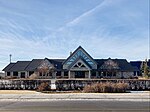Edmonton International Speedway
1966 establishments in Alberta1982 disestablishments in AlbertaDefunct drag racing venuesDefunct motorsport venues in CanadaDefunct sports venues in Canada ... and 5 more
Demolished buildings and structures in AlbertaDemolished sports venuesSports venues completed in 1953Sports venues demolished in 1982Sports venues in Edmonton

Edmonton International Speedway, also known as Speedway Park, was a 251-acre (1.02 km2) multi-track auto racing facility located in the present Cumberland and Hudson neighbourhoods of Edmonton, Alberta, Canada. The facility featured a 1⁄4-mile (400 m) dragstrip, a 2.53-mile (4.07 km) 14-turn road course, and a 1⁄4-mile short oval. At its peak, it had capacity for over 30,000 fans.
Excerpt from the Wikipedia article Edmonton International Speedway (License: CC BY-SA 3.0, Authors, Images).Edmonton International Speedway
HudsonBike Park, Edmonton The Palisades
Geographical coordinates (GPS) Address Nearby Places Show on map
Geographical coordinates (GPS)
| Latitude | Longitude |
|---|---|
| N 53.607 ° | E -113.557 ° |
Address
Hilwie Hamdon School
HudsonBike Park
T6V 1J7 Edmonton, The Palisades
Alberta, Canada
Open on Google Maps




